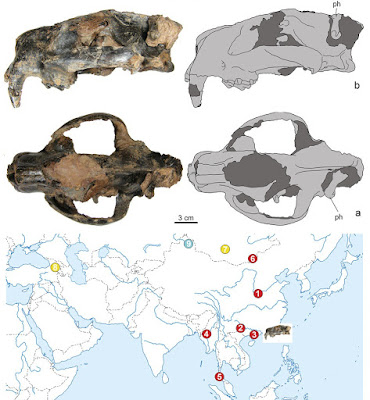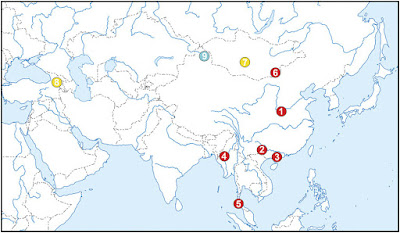|
|
| Пишет Species New to Science ( @ 2016-05-22 10:30:00 |
|
|
|
|
|
|
|
|
|
|
|
|
|
|
[PaleoMammalogy • 2016] Maofelis cantonensis • First Nimravid Skull from Asia
 |
| Maofelis cantonensis Averianov, Obraztsova, Danilov, Skutschas & Jin, 2016 DOI: 10.1038/srep25812 |
Abstract
Maofelis cantonensis gen. and sp. nov. is described based on a complete cranium from the middle-upper Eocene Youganwo Formation of Maoming Basin, Guangdong Province, China. The new taxon has characters diagnostic for Nimravidae such as a short cat-like skull, short palate, ventral surface of petrosal dorsal to that of basioccipital, serrations on the distal carina of canine, reduced anterior premolars, and absence of posterior molars (M2-3). It is plesiomorphic nimravid taxon similar to Nimravidae indet. from Quercy (France) in having the glenoid pedicle and mastoid process without ventral projections, a planar basicranium in which the lateral rim is not ventrally buttressed, and P1 present. The upper canine is less flattened than in other Nimravidae. Maofelis cantonensis gen. and sp. nov. exemplifies the earliest stage of development of sabertooth specialization characteristic of Nimravidae. This taxon, together with other middle-late Eocene nimravid records in South Asia, suggests origin and initial diversification of Nimravidae in Asia. We propose that this group dispersed to North America in the late Eocene and to Europe in the early Oligocene. The subsequent Oligocene diversification of Nimravidae took place in North America and Europe, while in Asia this group declined in the Oligocene, likely because of the earlier development of open habitats on that continent.
Systematic paleontology
Mammalia Linnaeus, 1758
Carnivora Bowdich, 1821
Nimravidae Cope, 1880
Maofelis cantonensis gen. et sp. nov.
 |
| Figure 2: SYSU-M 2, holotype of Maofelis cantonensis gen. and sp. nov., in dorsal (a), lateral (b) and ventral (c) views, photographs and explanatory drawings. DOI: 10.1038/srep25812 |
Holotype: Collection from the Maoming Basin in the School of Life Sciences, Sun Yat-sen University, Guangzhou, China (SYSU-M) 2, almost complete cranium (skull without mandible), with most of the dentition preserved.
Diagnosis: Maofelis is referred to Nimravidae based on the following combination of characters that is diagnostic for this group1,2: cat-like skull with shortened rostrum and mesocranium; palate short, does not extend posterior to the toothrow; walls of the basipharyngeal canal converged posteriorly; ventral surface of petrosal significantly dorsal to that of basioccipital; hypoglossal foramen separated from the posterior lacerate foramen; paraoccipital process moderately large, posteriorly projecting; incisors with reduced lingual cingula; serrations on the distal carina of canine; anterior premolars reduced; P4 without a parastyle; posterior molars (M2–3) absent.
Type locality and horizon: The oil shale quarry (21°42′ N, 110°53′ E) located near Maoming City, Maoming Basin, Guangdong Province, China; Youganwo Formation, middle-upper Eocene.
 |
| Figure 1: Map showing the known record of Nimravidae in Asia (red circles – Eocene, yellow – Oligocene, blue – Miocene). (1) Lushi Basin, Henan Province, China, Lushi Fm., middle Eocene, cf. Eusmilus sp., canine fragments; (2) Bose Basin, Guangxi Province, China, Dongjin Fm., middle Eocene, Hoplophoneus? sp. or Eusmilus? sp., canine fragments; (3) Maoming Basin, Guangdong Province, China, Youganwo Fm., middle-upper Eocene, Maofelis cantonensis, skull (this report); (4) Pondaung, Myanmar, Pondaung Fm., middle-upper Eocene, Nimravus sp., dentary fragment; (5) Krabi Basin, Thailand, Formation B2, upper Eocene, Nimravus cf. intermedius and Hoplophoneus sp., maxilla and dentary fragments, isolated teeth; (6) Khoer Dzan and Ergilin Dzo, Mongolia, Ergilin Dzo Fm., upper Eocene, Nimravus intermedius (= N. mongoliensis), dentary fragments; (7) Tatal Gol and Taatsin Gol, Mongolia, Hsanda Gol Fm., lower Oligocene, Nimravus mongoliensis and Nimravidae indet., dentary fragments; (8) Benara, Georgia, upper Oligocene, Nimravidae indet., isolated m1; (9) Tieersihabahe, Xinjiang Uyghur Autonomous Region, China, Halamagai Fm., middle Miocene, Nimravidae indet., dentary fragment. The map was generated by A. Averianov using Adobe Photoshop CS3 program. DOI: 10.1038/srep25812 |
Etymology: The generic name is from Maoming Basin in Guangdong Province where the skull was found, and the felid genus Felis. The species name is from Canton, an older name of Guangzhou City.
Alexander Averianov, Ekaterina Obraztsova, Igor Danilov, Pavel Skutschas and Jianhua Jin. 2016. First Nimravid Skull from Asia. Scientific Reports. 6, (25812). DOI: 10.1038/srep25812